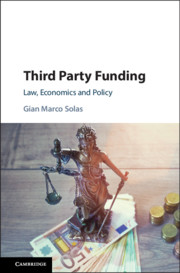1 - Introduction
Published online by Cambridge University Press: 16 September 2019
Summary
This chapter introduces the main problems and the basic terminology of the book. It presents the main discussions on the third party funding (TPF) business phenomenon in the wider litigation market context. This chapter also explains the structure and the methodology applied to the book, which is divided into three logically consequential parts, having different but at the same time inter-related approaches. The first part is a comparative legal and factual overview, which starts with the history of some litigation funding practices in early civil law and common law jurisdictions, and then reports the main legal facts related to modern TPF practice. The second part is an initial economic analysis of the business phenomenon, which describes the TPF practice in the wider litigation market context, and analyses its incentives both in private transactions and at a more general social level. The third part, building on the first two, provides an insight into the current legal, practical and regulatory issues related to TPF transactions and related proceedings, and discusses some policies or other measures that could improve its use in a wider litigation market.
- Type
- Chapter
- Information
- Third Party FundingLaw, Economics and Policy, pp. 1 - 14Publisher: Cambridge University PressPrint publication year: 2019

